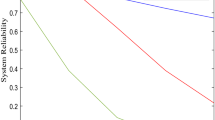Abstract
In this paper, we study some operational quality measures of the k-out-of-n systems. Performance of these systems is characterized by a quality (output) function that is decreasing in the absence of components’ failures. Moreover, it decreases (downward jump) with each failure of a component in a system as well. We employ the point processes approach for description of the corresponding failure process and derivation of the main results. Expectations (unconditional and conditional on survival) and variability for the system’s quality function are derived and analyzed. The corresponding ‘future quality process’ is defined and described. Some illustrative examples are presented.




Similar content being viewed by others
References
Aven T, Jensen U (1999) Stochastic models in reliability. Springer, New York
Aven T, Jensen U (2000) A general minimal repair model. J Appl Probab 37:187–197
Boland PJ, Proschan F (1983) The reliability of k out of n systems. Ann Prob 11:760–764
Cha JH (2014) Characterization of the generalized Pólya process and its applications. Adv Appl Prob 46:1148–1171
Cha JH, Finkelstein M (2011) Stochastic intensity for minimal repairs in heterogeneous populations. J Appl Prob 48:868–876
Cha JH, Finkelstein M (2018) Point processes for reliability analysis. Shocks and repairable systems. Springer, London
Cha JH, Finkelstein M (2019a) On some characteristics of quality for systems operating in a random environment. Proc Inst Mech Eng Part O 233:257–267
Cha JH, Finkelstein M (2019b) Optimal preventive maintenance for systems having a continuous output and operating in a random environment. TOP 27:327–350
Ding Y, Zuo MJ, Lisnianski A, Li W (2010) A framework for reliability approximation of multi-state weighted k-out-of-n systems. IEEE Trans Reliab 59:297–308
Eryilmaz S (2013) Reliability of a k-out-of-n system equipped with a single warm standby component. IEEE Trans Reliab 62:499–503
Eryilmaz S, Navarro J (2012) Failure rates of consecutive k-out-of-n systems. J Korean Stat Soc 41:1–11
Finkelstein M (2003) The performance quality of repairable systems. Qual Reliab Eng Int 19:67–72
Finkelstein M (2008) Failure rate modeling for reliability and risk. Springer, London
Finkelstein M, Cha JH (2013) Stochastic modelling for reliability (Shocks, burn-in and heterogeneous populations). Springer, London
Ghoraf N (2008) Reliability formula and limit law of the failure time of “m-consecutive-k-out-of-n: F system”. TOP 16:62
Ghoraf N, Boushaba M (2003) Fast formula of a reliability of m-consecutive-k-out-of-n: F system with cycle k. TOP 11:275
Hsieh CC, Chiu KC (2002) Optimal maintenance policy in a multistate deteriorating standby system. Eur J Oper Res 141:689–698
Krishnamoorthy A, Ushakumari PV (1999) Reliability of a k-out-of-n system with repair and retrial of failed units. TOP 7:293–304
Lee H, Cha JH (2016) Point processes approach to modeling and analysis of general cascading failures models. J Appl Prob 53:174–186
Leemis LM (1995) Reliability: probabilistic models and statistical methods. Prentice Hall, New Jersey
Levitin G (2013) Multi-state vector k-out-of-n systems. IEEE Trans Reliab 62:648–657
Levitin G, Xing L, Dai Y (2015) Linear multistate consecutively-connected systems subject to a constrained number of gaps. Reliab Eng Syst Saf 133:246–252
Lisniansky A, Levitin G (2003) Multi-state system reliability: assessment, optimization and applications. World Scientific, Singapore
Lisniansky A, Frenkel I, Ding Y (2010) Multistate systems reliability analysis and applications for engineers and industrial managers. Springer, London
Marichal JL, Mathonet P, Navarro J, Paroissin C (2017) Joint signature of two or more systems with applications to multistate systems made up of two-state components. Eur J Oper Res 263:559–570
Meng FC (2005) Comparing two reliability upper bounds for multistate systems. Reliab Eng Syst Saf 87:31–36
Natvig B (2010) Multistate systems reliability theory with applications. Wiley, Chichester
Navarro J, Eryilmaz S (2007) Mean residual lifetimes of consecutive-k-out-of-n systems. J Appl Prob 44:82–98
Navarro J, Longobardi M, Pellerey F (2017) Comparison results for inactivity times of k-out-of-n and general coherent systems with dependent components. Test 26:822–846
Rausand M, Hoyland A (2004) System reliability theory: models, statistical methods and applications, 2nd edn. Wiley, New Jersey
Yeh WC (2008) A simple minimal path method for estimating the weighted multi-commodity multistate unreliable networks reliability. Reliab Eng Syst Saf 93:125–136
Acknowledgements
The authors would like to thank referees for helpful comments and advices. The work of the first author was supported by the National Research Foundation of Korea (NRF) grant funded by the Korea government (MSIP) (No. 2019R1A2B5B02069500). The work of the first author was also supported by Basic Science Research Program through the National Research Foundation of Korea (NRF) funded by the Ministry of Education (Grant Number: 2019R1A6A1A11051177).The work of the second author was supported by National Research Foundation (SA) (Grant No: 103613).
Author information
Authors and Affiliations
Corresponding author
Additional information
Publisher's Note
Springer Nature remains neutral with regard to jurisdictional claims in published maps and institutional affiliations.
Appendix
Appendix
1.1 Proof of Lemma 1
Let \(s_{0} \equiv 0\), \(s_{m + 1} \equiv t\), \(\Delta t_{0} \equiv 0\), and \(\Delta t_{j}\) is infinitesimally small so that \(s_{j} + \Delta t_{j} < s_{j + 1}\), \(j = 1,2, \ldots ,m\). Then, using the notion of stochastic intensity,
Denote by \(f_{{S_{1} ,S_{2} , \ldots ,S_{N(t)} ,N(t)}} (s_{1} ,s_{2} , \ldots ,s_{m} ,m)\) the joint distribution of \((S_{1} = s_{1} ,S_{2} = s_{2} , \ldots ,S_{m} = s_{m} ,N(t) = m)\). Then
1.2 Proof of Theorem 4
Denote by \(\{ s_{1} ,s_{2} , \ldots ,s_{n(s)} ,n(s)\}\) the realization of \(\{ S_{1} ,S_{2} , \ldots ,S_{N(s)} ,N(s)\}\). By definition,
where \(n(s) \le n - k\), \(N_{s} (t) = N(s + t) - N(s)\), \(S_{j}^{*}\) is the time from \(s\) to the \(j\) th component’s failure occurred in \((s,s + t]\), \(j = 1,2, \ldots ,N_{s} (t)\). Note that, given \(\{ s_{1} ,s_{2} , \ldots ,s_{n(s)} ,n(s)\}\), at time \(s\) the system is the \(k\)-out-of \(n - n(s)\) system with the common components failure rate \(\lambda (s + u)\), \(u \ge 0\). Thus, applying similar procedure as that in the proof of Theorem 1,
where \(\varLambda_{s} (t) = \int_{0}^{t} {\lambda (s + w)} dw\), \(\lambda_{sj} (t|v_{1} ,v_{2} , \ldots ,v_{j} ) = (n - n(s) - j)\lambda (s + t)\), \(j = 0,1,2, \ldots ,n - n(s) - k\), \(\varLambda_{sj} (u_{1} ,u_{2} ) = \int_{{u_{1} }}^{{u_{2} }} {\lambda_{sj} (w|v_{1} ,v_{2} , \ldots ,v_{j} )} dw\).
Observe that
Again, given \(\{ s_{1} ,s_{2} , \ldots ,s_{n(s)} ,n(s)\}\) at time \(s\), the system is the \(k\)-out-of \(n - n(s)\) system with the common components failure rate \(\lambda (s + u)\), \(u \ge 0\). Thus,
and
1.3 Proof of Theorem 5
Observe that
where \(E_{{(\{ S_{1} ,S_{2} , \ldots ,S_{N(s)} ,N(s)\} |T > s)}} [ \cdot ]\) stands for the expectation with respect to the conditional joint distribution \((\{ S_{1} ,S_{2} , \ldots ,S_{N(s)} ,N(s)\} |T > s)\). From Theorem 4
and the conditional joint distribution \((\{ S_{1} ,S_{2} , \ldots ,S_{N(s)} ,N(s)\} |T > s)\) is given by
Let
Then
On the other hand, by definition, \(Q_{ES} (t|T > s) = E[\tilde{Q}(s + t)|T > s + t] = Q_{ES} (s + t)\)
Rights and permissions
About this article
Cite this article
Cha, J.H., Finkelstein, M. Stochastic modelling of operational quality of k-out-of-n systems. TOP 28, 424–441 (2020). https://doi.org/10.1007/s11750-019-00536-y
Received:
Accepted:
Published:
Issue Date:
DOI: https://doi.org/10.1007/s11750-019-00536-y




